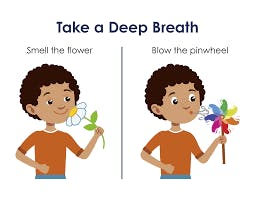By: Priyanka Jariwala, PT, MS
Breathe Deeply
Here is food for thought: an average person takes 16 breaths per minute. Therefore, a person who lives to the age of 80 years, will end up taking 672,768,000 breaths in their lifetime! Let that number sink in and understand why this is so important.
As our bodies, environments and health undergo changes, so do our breathing patterns. Somewhere during our life’s journey, we end up turning into shallow breathers, using accessory muscles from our neck, back, shoulders or holding tension in our body when breathing. Our diaphragm, which is located below our rib cage and center of our belly, is the primary breathing muscle along with external intercostals, which helps us breathe.

Taking deep breaths throughout the day can establish a sense of grounding, and help us reduce unchecked tension in our body. It can act as a stress reliever and modulate the reaction to the day to day strains in life. After all, it is difficult for the body to maintain the same level of stress with extra oxygen in our blood when we breathe from the diaphragm.
A Breathing Exercise
Let’s try this exercise…Take a deep breath right now, let your shoulders relax and allow your abdomen to puff out as you take a deep breath in through the nose… hold…now slowly breath out through your mouth. Repeat this 5 times. The relaxing feeling that you are experiencing is your parasympathetic nervous system responding.

We tend to spend the majority of our time and days running on sympathetic overdrive aka the flight or flight response. This response can cause elevated heart rate, sweating, tensing of muscles and quickening of breathing (sympathetic response) all of which can take a long term toll on the body contributing to high blood pressure, anxiety, depression and addiction. Think of both of the above systems as the accelerator (sympathetic system) and brakes on your car (parasympathetic system). Learning how to use the brakes can help decrease cortisol levels (primary stress hormone)and relax the mind and body.
Proper Breathing Technique
Some studies have also suggested a link between improper breathing technique and chronic low back and neck pain. One such study demonstrated a strong association between increased forward head posture and decreased respiratory muscle strength in neck patients.
Adopting a practice of diaphragmatic breathing has a lot of advantages: it can help you manage your pain, relieve stress, reduce tension, improve quality of sleep, decrease blood pressure, and more. All you need is your lungs, a place to stand, sit or lie down and the intention to breathe.

Priyanka Jariwala, is Clinical Director at Performance Rehabilitation in Yonkers. She specializes in orthopedic and sports related injuries and is an expert in human kinesiology. Using an approach called Selective Functional Movement Analysis (SFMA), Priyanka is able discern subtle abnormalities in a individual’s movement and target the tissues that are causing the abnormalities. She frequently utilizes specialized instrumentation to effectively loosen these tissues and employs a wide variety of creative exercises that help restore mobility, strength and function. Priyanka is very motivating and while she develops a caring relationship with her patients, she will push her patients to maximize their potential.
